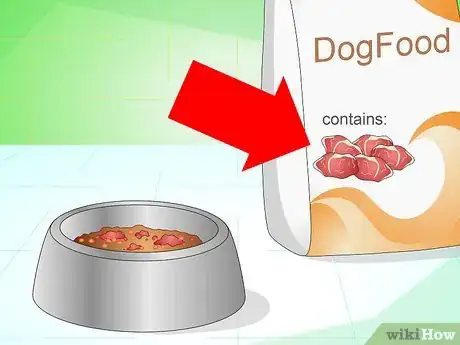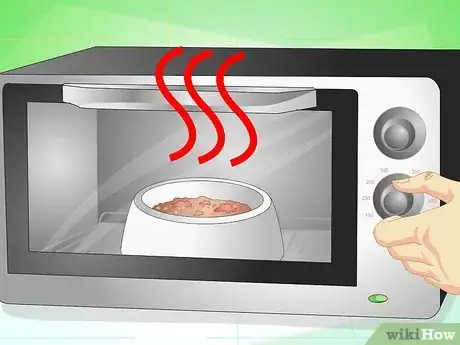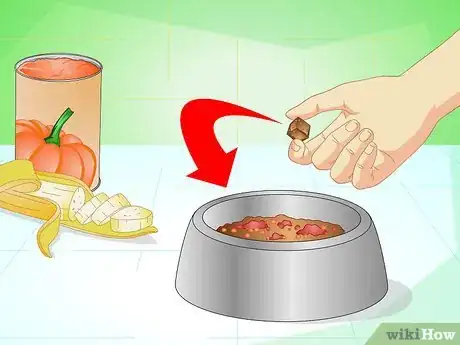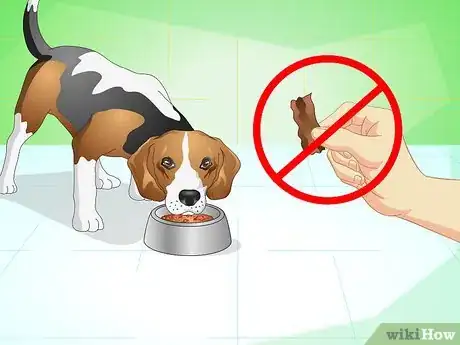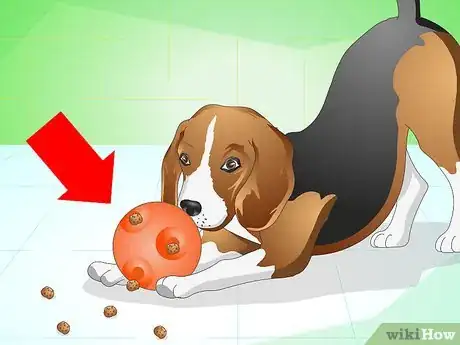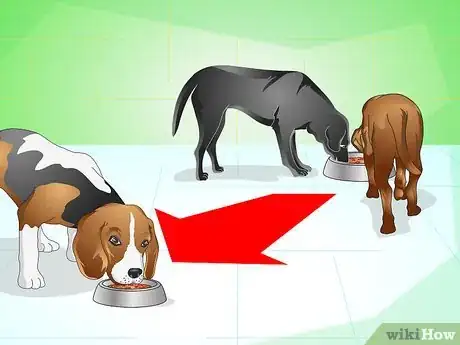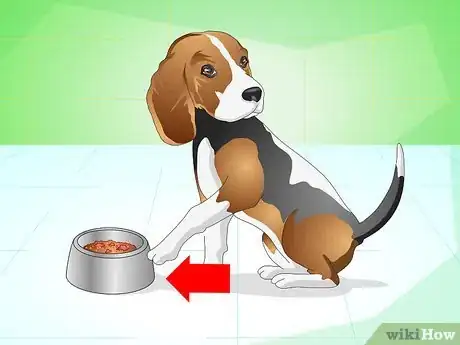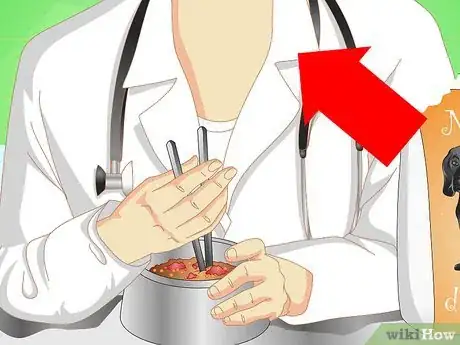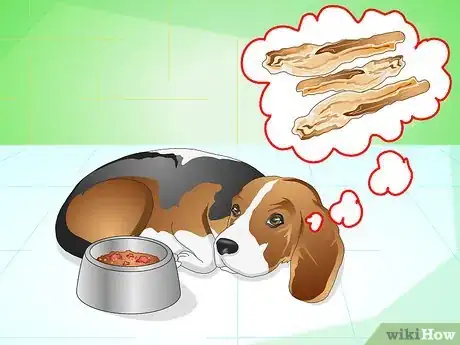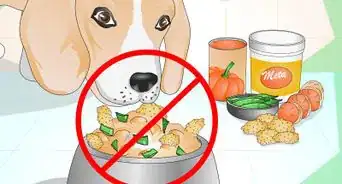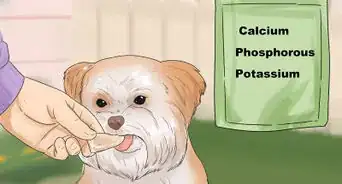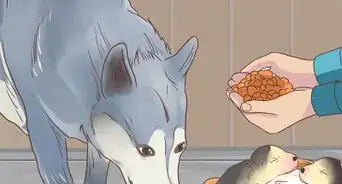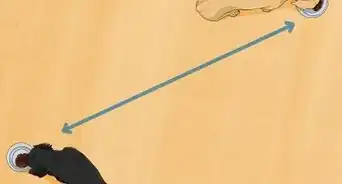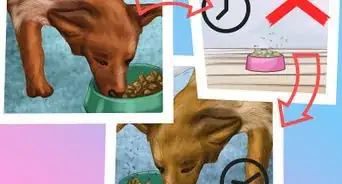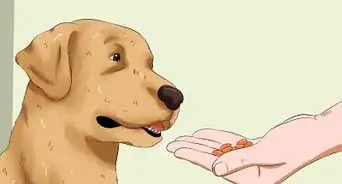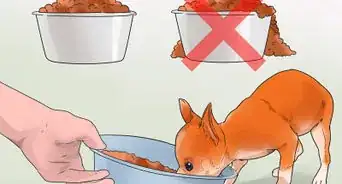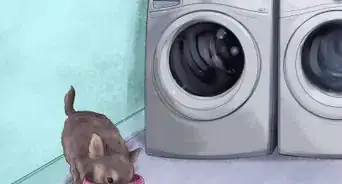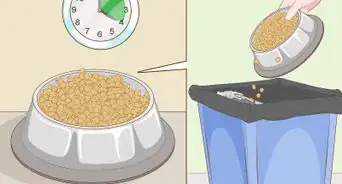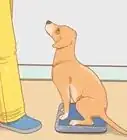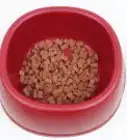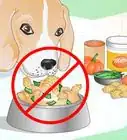This article was co-authored by Brian Bourquin, DVM. Brian Bourquin, better known as “Dr. B” to his clients, is a Veterinarian and the Owner of Boston Veterinary Clinic, a pet health care and veterinary clinic with three locations, South End/Bay Village, the Seaport, and Brookline, Massachusetts. Boston Veterinary Clinic specializes in primary veterinary care, including wellness and preventative care, sick and emergency care, soft-tissue surgery, dentistry. The clinic also provides specialty services in behavior, nutrition, and alternative pain management therapies using acupuncture, and therapeutic laser treatments. Boston Veterinary Clinic is an AAHA (American Animal Hospital Association) accredited hospital and Boston’s first Fear Free Certified Clinic. Brian has over 19 years of veterinary experience and earned his Doctor of Veterinary Medicine from Cornell University.
There are 10 references cited in this article, which can be found at the bottom of the page.
This article has been viewed 102,925 times.
It's hard to know what to do if your dog is a picky eater, especially when it comes to dry dog food versus wet dog food. There are some dogs that absolutely refuse to eat their dog food, especially dry kibble. This can be dangerous since dog foods are formulated to meet all of a dog's nutritional needs while a human diet will not meet these needs. By being choosy and refusing to eat, a dog could end up nutritionally deficient and develop serious health problems in his bones, joints, and teeth.
Steps
Making Your Dog's Food Appealing
-
1Try integrating dry kibble into wet food. Dogs will sometimes fight you on eating their dry food, the kibble. To your dog to eat his dry food, mix some wet food with the desired dry food. That way, your dog will still get the taste of wet dog food while also consuming the dry dog food at the same time. However, make sure you completely mix the wet and dry food or else the dog will only consume the wet food, leaving the dry food in its bowl. Each week, feed your dog less and less wet food until you are completely feeding him dry dog food. Your dog should get used to this and will soon be eating the dry dog food without any complaint.[1] [2]
-
2Make sure the dog food is meat-based. Odor, taste, temperature or texture can all be manipulated to tempt your reluctant dog to eat. Dogs prefer the taste and odor of meat over grains. Check the ingredient labels on the dog food brand you've been feeding your dog. If meat (not meat by-product) is not the first ingredient listed, try another brand.[3]
- In addition, keep away from dog foods that list corn as one of main ingredients. A diet with corn listed as a main ingredient is less suited to a canine digestion than a meat-rich diet. It is a sign of cost-cutting by the manufacturer as corn is often used a cheap bulking agent.
Advertisement -
3Warm the food. Warming dog food will intensify its smell and will hopefully entice your dog to eat the food.[4] This works best with canned food. If you are trying to feed dry food, add some warm water to the food to soften it.
-
4Make some additions. Add a small amount of meat broth (which can be warmed first) or a tablespoon of pureed banana or pumpkin to the food. You can also add cottage cheese or a bit of cooked egg. These are all foods that dogs typically enjoy and their addition to the dog food may incentivize your dog to eat it.[5]
- None of these additions should be more than 10% of the total daily food allowance.
-
5Limit treats. In fact, try to discontinue treats altogether and only feed your dog twice a day until he is regularly eating dog food. After your dog has successfully become a normal eater, do not use human food as a treat—only dog treats or dog foods.[6]
- If you are trying to work out if the dog is ill and this is reason he's not eating, then try him with a favorite food. If he wolfs it down then he's being picky, but if he doesn't eat even that then he may be ill and should see a vet.
- Avoid chopping and changing foods as this gives the dog the message that if he doesn't eat he gets offered an alternative.
- If you try three brands and both wet and dry food, it may be time to talk to your vet.
-
6Mix old food with new food. If you suspect that the problem is that you've been trying out a new brand and your dog doesn't seem to be taking to it, try mixing the old and new food together first. Start out by mixing a small amount of the new food in with the old and, over the course of one to two weeks, gradually increase the ratio of the new food and decrease the ratio of the old food until your dog is only consuming the new food.[7]
-
7Make mealtimes more fun. To help encourage your pet to eat, consider making feeding times more fun and exciting for him. For example, try playing with a dog toy that dispenses food. Alternately, make food the reward for when your dog does a trick, such as shaking a paw or rolling over. If done repeatedly, your dog may come to associate that food he previously did not like as a reward and be more inclined to eat it.[8]
-
8Exercise your dog before feeding time. Try taking your dog for a walk before giving him his food or playing fetch with him for a while in your backyard. As he burns energy and calories and hopefully builds up an appetite through this exercise, your dog might be more willing to eat when his food is put in front of him.[9]
-
9Change up the feeding routine. Make some adjustments to mealtimes to see if any of these make your dog more willing to eat his food:[10]
- If you usually feed him alongside your other pets, try feeding him alone. Put his dish in another, separate room. Try the opposite if you tend to feed him alone.
- Use a different food dish for his food.
- Place the food dish in a different location in the room or at a different height.
- Put some of the food beside his dish as well as in it.
-
10Don't give in. If your dog is healthy otherwise, don't stress right away if he refuses to eat for several days. Some dogs can be quite stubborn when being forced to eat a dog food diet. While it is not desirable that your dog starves himself, he will not come to any harm if he doesn't eat for a couple of days, though he might lose a little weight. Indeed, dogs that starve themselves for weeks to months do not come to harm, although they will obviously become very thin. After a week or so, you then may want to consult your vet for other strategies.[11]
- Leave the food out for 15 minutes in the room and leave the room yourself so the dog has no audience to play to. If he doesn't eat it within that time-frame, take it away. Throw uneaten food away, as wet food tends to dry out once it's been opened and so will lose it's appeal. Your dog will eventually choose dog food over no food. You just have to wait him out.
- It is only by resisting the urge to switch foods and give your dog what he wants when he doesn't eat that he will learn that you mean business.
-
11Get assistance. In a few cases, you may decide to cook a home-made special diet for your dog. This can make a perfectly acceptable diet for your dog, provided you work closely with a pet nutritionist to formulate a well-balanced diet.[12]
- There are some veterinarians who have training in pet diet formulations. Otherwise, veterinary colleges generally have a nutritionist on staff or can direct you to reliable online resources to help you come up with an acceptable diet which is affordable for you and palatable to your dog.
Understanding Picky Eaters
-
1Realize that your dog may be a picky eater by choice. Picky eaters by choice know there is something better out there than dog food, especially dry food, and will hold out for that better alternative, whether that means wet dog food or pieces of bacon from their owner's plate.[13]
-
2Consider whether a medical reason might be at work. This would be a dog that was previously eating dog food without a problem who now suddenly nibbles at the food or leaves it in its dish. You may notice your dog losing weight or exhibiting signs of illness, such as lethargy or slowness.[14]
-
3Understand the impact of picky eating. Your dog will eventually become nutritionally deficient if he is not eating a well-balanced diet. Dog food is formulated to meet all the nutritional needs of dogs. They are not humans and thus cannot thrive on a human diet. Dogs have different requirements than humans for fat, protein, minerals and vitamins. Here are some of the potential implications of a poor diet:[15] [16]
- Poor teeth: The dog's teeth will suffer, especially small breed dogs, if he doesn't eat properly. Dry dog food (kibble) helps to “grind” off some of the plaque that eventually collects on the teeth. In addition, a nutritionally imbalanced diet will eventually make the dog deficient in minerals like calcium which helps build strong teeth and bones.
- Obesity: Generally, picky eaters will only eat the tastiest human foods which typically contain a lot of fat. Fat is what gives the most flavor to food. Too much fat in the diet equals an expanding waistline, even in dogs. At present, obesity is the biggest nutritional problem facing our pet dogs.
- Future health concerns and lower quality of life: Many of the common illnesses facing aging dogs are treated with special foods which help prolong life and increase quality of life. Unfortunately, some of these foods aren't as flavorful as regular dog food and may be rejected by a picky eater. Failure to eat these foods could limit the treatments available for aging illnesses and hasten a dog's physical decline.
Expert Q&A
-
QuestionWhat should I do if my dog won't eat their normal dog food?
 Brian Bourquin, DVMBrian Bourquin, better known as “Dr. B” to his clients, is a Veterinarian and the Owner of Boston Veterinary Clinic, a pet health care and veterinary clinic with three locations, South End/Bay Village, the Seaport, and Brookline, Massachusetts. Boston Veterinary Clinic specializes in primary veterinary care, including wellness and preventative care, sick and emergency care, soft-tissue surgery, dentistry. The clinic also provides specialty services in behavior, nutrition, and alternative pain management therapies using acupuncture, and therapeutic laser treatments. Boston Veterinary Clinic is an AAHA (American Animal Hospital Association) accredited hospital and Boston’s first Fear Free Certified Clinic. Brian has over 19 years of veterinary experience and earned his Doctor of Veterinary Medicine from Cornell University.
Brian Bourquin, DVMBrian Bourquin, better known as “Dr. B” to his clients, is a Veterinarian and the Owner of Boston Veterinary Clinic, a pet health care and veterinary clinic with three locations, South End/Bay Village, the Seaport, and Brookline, Massachusetts. Boston Veterinary Clinic specializes in primary veterinary care, including wellness and preventative care, sick and emergency care, soft-tissue surgery, dentistry. The clinic also provides specialty services in behavior, nutrition, and alternative pain management therapies using acupuncture, and therapeutic laser treatments. Boston Veterinary Clinic is an AAHA (American Animal Hospital Association) accredited hospital and Boston’s first Fear Free Certified Clinic. Brian has over 19 years of veterinary experience and earned his Doctor of Veterinary Medicine from Cornell University.
Veterinarian If your previously normal eater stops eating its regular food, it's a good idea to talk to your vet.
If your previously normal eater stops eating its regular food, it's a good idea to talk to your vet. -
QuestionWhy is my dog not eating his food but will eat treats?
 Brian Bourquin, DVMBrian Bourquin, better known as “Dr. B” to his clients, is a Veterinarian and the Owner of Boston Veterinary Clinic, a pet health care and veterinary clinic with three locations, South End/Bay Village, the Seaport, and Brookline, Massachusetts. Boston Veterinary Clinic specializes in primary veterinary care, including wellness and preventative care, sick and emergency care, soft-tissue surgery, dentistry. The clinic also provides specialty services in behavior, nutrition, and alternative pain management therapies using acupuncture, and therapeutic laser treatments. Boston Veterinary Clinic is an AAHA (American Animal Hospital Association) accredited hospital and Boston’s first Fear Free Certified Clinic. Brian has over 19 years of veterinary experience and earned his Doctor of Veterinary Medicine from Cornell University.
Brian Bourquin, DVMBrian Bourquin, better known as “Dr. B” to his clients, is a Veterinarian and the Owner of Boston Veterinary Clinic, a pet health care and veterinary clinic with three locations, South End/Bay Village, the Seaport, and Brookline, Massachusetts. Boston Veterinary Clinic specializes in primary veterinary care, including wellness and preventative care, sick and emergency care, soft-tissue surgery, dentistry. The clinic also provides specialty services in behavior, nutrition, and alternative pain management therapies using acupuncture, and therapeutic laser treatments. Boston Veterinary Clinic is an AAHA (American Animal Hospital Association) accredited hospital and Boston’s first Fear Free Certified Clinic. Brian has over 19 years of veterinary experience and earned his Doctor of Veterinary Medicine from Cornell University.
Veterinarian Sometimes, dogs become picky eaters when their owners spoil them with tasty table tidbits or reward their picky eating by hand-feeding or offering an even more tasty alternative.
Sometimes, dogs become picky eaters when their owners spoil them with tasty table tidbits or reward their picky eating by hand-feeding or offering an even more tasty alternative. -
QuestionHow long can a dog go without food or water?
 Pippa Elliott, MRCVSDr. Elliott, BVMS, MRCVS is a veterinarian with over 30 years of experience in veterinary surgery and companion animal practice. She graduated from the University of Glasgow in 1987 with a degree in veterinary medicine and surgery. She has worked at the same animal clinic in her hometown for over 20 years.
Pippa Elliott, MRCVSDr. Elliott, BVMS, MRCVS is a veterinarian with over 30 years of experience in veterinary surgery and companion animal practice. She graduated from the University of Glasgow in 1987 with a degree in veterinary medicine and surgery. She has worked at the same animal clinic in her hometown for over 20 years.
Veterinarian A dog can go without food for around three weeks, although this isn't recommended and they will get very thin. However, water is essential. A dog's cells depend on water and their body is around 70% water. A dog will become extremely sick with as few as 2 or 3 days without water.
A dog can go without food for around three weeks, although this isn't recommended and they will get very thin. However, water is essential. A dog's cells depend on water and their body is around 70% water. A dog will become extremely sick with as few as 2 or 3 days without water.
Warnings
- Make any food changes gradually. A sudden switch may upset your dog's stomach, causing vomiting and/or diarrhea.⧼thumbs_response⧽
- If your dog was previously a good eater and suddenly becomes picky, contact your veterinarian if this continues for more than two days.⧼thumbs_response⧽
References
- ↑ http://www.hillspet.com/dog-care/what-do-about-finicky-eater-adult-dog.html
- ↑ http://www.petmd.com/dog/nutrition/evr_dg_changing_dog_food_brands_quickly
- ↑ http://pets.webmd.com/dogs/guide/when-your-dog-is-a-picky-eater?page=3
- ↑ Brian Bourquin, DVM. Veterinarian. Expert Interview. 20 December 2019.
- ↑ https://www.aspca.org/pet-care/dog-care/general-dog-care
- ↑ http://www.hillspet.com/dog-care/what-do-about-finicky-eater-adult-dog.html
- ↑ http://www.petmd.com/dog/nutrition/evr_dg_changing_dog_food_brands_quickly
- ↑ http://pets.webmd.com/dogs/guide/dog-not-eating-possible-causes-and-appetite-solutions?page=2
- ↑ http://pets.webmd.com/dogs/guide/dog-not-eating-possible-causes-and-appetite-solutions?page=2
- ↑ http://pets.webmd.com/dogs/guide/dog-not-eating-possible-causes-and-appetite-solutions?page=2
- ↑ http://pets.webmd.com/dogs/guide/when-your-dog-is-a-picky-eater?page=2
- ↑ https://www.aspca.org/pet-care/pet-nutrition-service
- ↑ http://pets.webmd.com/dogs/guide/when-your-dog-is-a-picky-eater
- ↑ http://pets.webmd.com/dogs/guide/when-your-dog-is-a-picky-eater
- ↑ Behavior Problems of the Dog and Cat3: Behavior Problems of the Dog and Cat. G. M. Landsberg, W. L. Hunthausen, and L. J. Ackerman Elsevier Health Sciences, 2012
- ↑ http://www.hillspet.com/dog-care/what-do-about-finicky-eater-adult-dog.html
- ↑ http://www.hillspet.com/dog-care/what-do-about-finicky-eater-adult-dog.html
About This Article
To get your dog to eat the dog food it doesn't like, mix its favorite wet food into the dry kibble. Warming wet food briefly in the microwave or adding a splash of warm water to kibble may be helpful. You can also try including a small amount of people food to entice your dog. For example, add warmed meat broth, pureed banana or pumpkin, cottage cheese, or some cooked egg to the dog food. Exercising your dog right before meal time may also make it a little less picky! For tips on understanding why your dog is being picky about food, read on!

